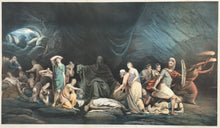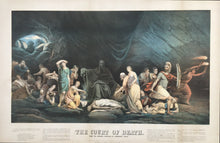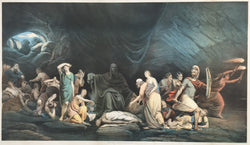Rembrandt Peale. "The Court of Death."
New York: G.Q. Colton, 1859. 15 x 26 1/2. Chromolithograph by Sarony & Major. Very good condition. With descriptive key in bottom margin. Scattered very faint spotting in margins. Faint vertical slat stain right hand side. Else, very good condition. Ref: Marzio, The Democratic Art, p. 51.
This print is after the painting by Rembrandt Peale (1778-1860). Born in Bucks County, Pennsylvania, he was the son of Charles Willson Peale. Rembrandt traveled to England and studied under Benjamin West from 1801 to 1803. A founder of the National Academy of Design, Peale is best known for his portrait of George Washington. Other important paintings of his are "Napoleon on Horseback," "The Roman Daughter," and portraits of Thomas Jefferson and Gilbert Stuart.
"The Court of Death," painted in 1820, was one of the most popular paintings of that decade. In the first year of its traveling exhibition, Peale earned over $8,000 in admissions, and it continued to be exhibited for half a century. The size of the canvas was a huge 11 feet by 23 feet, and was based upon a poem by the recently deceased Bishop of London, Beilby Porteus. Death is represented enthroned in a gloomy cave, his feet resting on the body of a man stricken in the prime of life. Surrounding him are his agents: War, Conflagration, Famine, Pestilence, Pleasure, Intemperance, Remorse, Delirium Tremens, Suicide, and an array of deadly diseases. Before the throne is Old Age who is supported by Faith. Members of the Peale family posed for most of the figures with the artist's daughter as the women and his famous father as "Old Age." Much was made in the time that the corpse was based on an actual cadaver from a medical school in Philadelphia. Two large prints were published by Colton but involved different processes. One was this chromolithograph printed by Sarony & Major, and the second was a wood engraving by Loomis and Annin.





